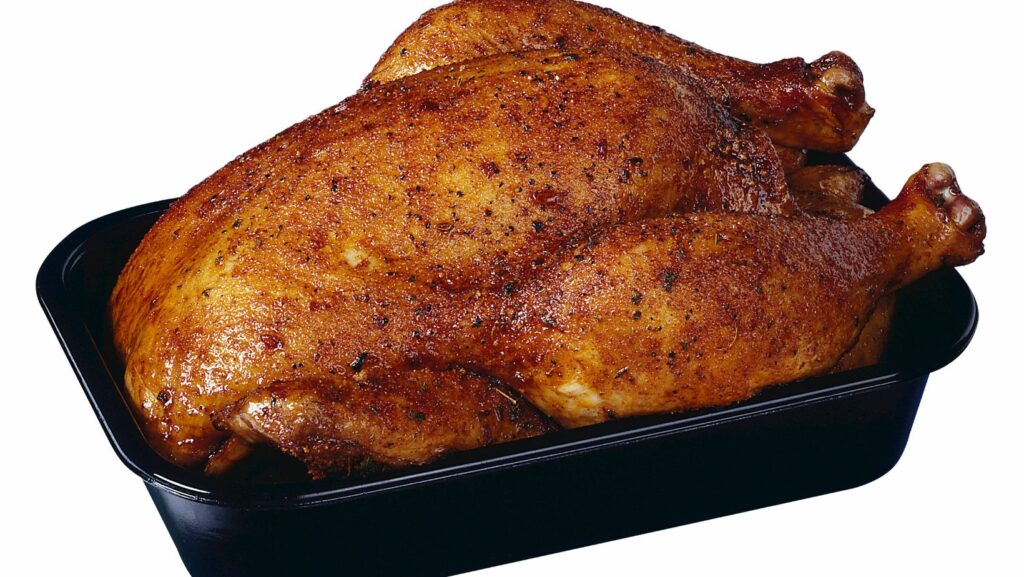Rotisserie chicken, a beloved staple in many homes, is more than just a convenient dinner option. It’s a versatile ingredient that can be the star of numerous healthy and delicious recipes. From hearty salads to satisfying soups, the possibilities are endless when you’ve got this tender, juicy poultry at your disposal.
Healthy Recipes Using Rotisserie Chicken
 Rotisserie chicken is not only versatile and delicious, but it’s also packed with nutritional benefits critical for a healthy lifestyle. Loaded with protein, it supports muscle growth and repair. Each 3-ounce serving of rotisserie chicken provides between 17 and 25 grams of protein—about 30% to 50% of the daily recommended intake.
Rotisserie chicken is not only versatile and delicious, but it’s also packed with nutritional benefits critical for a healthy lifestyle. Loaded with protein, it supports muscle growth and repair. Each 3-ounce serving of rotisserie chicken provides between 17 and 25 grams of protein—about 30% to 50% of the daily recommended intake.
Beyond being a high-protein food, rotisserie chicken is low in carbohydrates, fitting perfectly into low-carb and keto diet plans. It also offers essential vitamins and minerals. An example would be B-vitamins, particularly B3 and B6, which are crucial for producing energy and boosting metabolism.
Rotisserie chicken is also known to have selenium, a potent antioxidant that helps combat oxidative stress in the body. This little-known mineral aids in maintaining thyroid health, reducing inflammation, and enhancing immunity.
One potential drawback is the skin which contributes unhealthy saturated fats and sodium. By removing the skin, it’s possible to significantly decrease these values and enhance the overall nutritional profile.
Breaking Down Rotisserie Chicken
In an effort to truly appreciate the benefits of this flavorful poultry, it’s crucial to understand how to properly break down a rotisserie chicken. It begins with carefully removing the chicken from its packaging, where it’s been kept moist and warm. Next, the skin gets stripped away, as the skin houses considerable amounts of unhealthy fats and sodium, as mentioned in the previous section.
Subsequently, it’s time to separate the meat. Breakdown starts with the larger pieces, such as the breasts and thighs. These parts offer the greatest quantity of lean protein. Post this, the smaller pieces are tackled. Wings and legs, while smaller, still provide valuable protein servings. The remaining carcass, rich in nutrients, provides the base for nourishing broths and soups.
Each step in the breakdown process signifies the versatility of a rotisserie chicken, transforming a single item into multiple healthy recipes. This practice demystifies the process and amplifies the value offered by a rotisserie chicken in a balanced diet. Thus, the breakdown not only provides a wealth of nutritious ingredients, but a range of delicious opportunities.
Variety of Healthy Recipes using Rotisserie Chicken
 Rotisserie chicken offers limitless possibilities for crafting nutritious, mouth-watering meals. For instance, the tender breasts create an exceptional, protein-packed addition to salads and sandwiches. When chopped and mixed with greek yogurt, onions, celery, it morphs into a tasty chicken salad – superb for luncheons.
Rotisserie chicken offers limitless possibilities for crafting nutritious, mouth-watering meals. For instance, the tender breasts create an exceptional, protein-packed addition to salads and sandwiches. When chopped and mixed with greek yogurt, onions, celery, it morphs into a tasty chicken salad – superb for luncheons.
Legs and thighs, being darker cuts, lend a rich flavor to stir-fries and stews, elevating them from regular to exquisite. They provide a lean meat base, with each dish emphasizing different vegetables, grains, and seasonings.
Utilizing wings in appetizers gives a spin to the traditional, unhealthy fried versions. Glazing wings with a homemade sauce of honey, lemon, and ginger, then roasting them, yields a delightful, healthier alternative.
Tips for Making Your Rotisserie Chicken Recipe Healthier
 Without question, the rotisserie chicken lends itself to a plethora of recipes catering to health-conscious diners. To boost the health quotient, it’s advisable to remove the skin. This strips away excess fats and cuts down on calories. Make sure to include plenty of vibrant, nutrient-rich vegetables in the dish – think leafy greens, bell peppers, and zucchini. These not only infuse additional vitamins and minerals into the meal but also contribute to a satisfying crunch.
Without question, the rotisserie chicken lends itself to a plethora of recipes catering to health-conscious diners. To boost the health quotient, it’s advisable to remove the skin. This strips away excess fats and cuts down on calories. Make sure to include plenty of vibrant, nutrient-rich vegetables in the dish – think leafy greens, bell peppers, and zucchini. These not only infuse additional vitamins and minerals into the meal but also contribute to a satisfying crunch.
Sauces and dressings also play a major role. Opt for homemade versions over store-bought ones. You gain control over the ingredients, reducing the sodium and sugar levels tied to processed versions. It’s also worth selecting brown rice or whole-grain versions as accompaniments, over white rice or refined grain options, due to their higher fiber content.

